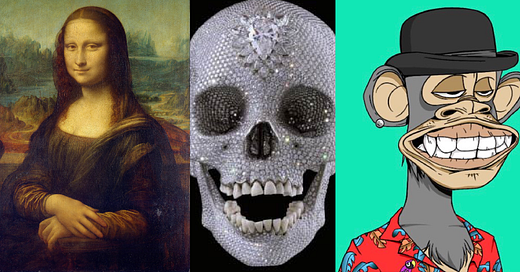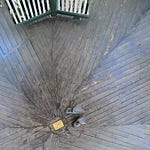I first took in the critical work of Robert Hughes at art college where we were shown weekly screenings of his 1970’s BBC series on modern art, The Shock of the New. However, the programme that really made an impression on me was his Channel 4 diatribe about the free market’s influence on what was seen as art at the turn of the millennium. In The Mona Lisa Curse, Hughes bemoans the narratives and strategies that centred the burgeoning art market as the main sphere of meaning and value within the worlds of classical and contemporary art. Starting from the moment when the Mona Lisa arrived in New York as part of a world tour in the 1960s, where the painting was treated like a kind of visiting celebrity, Hughes chronicles how rich investors profited from buying and selling works of art, with the artists themselves seeing little of it.
Not only did this influence how galleries presented exhibitions and the press/public perception of fiscal value as the chief metric for artistic worth; it also influenced the creation of art works themselves, with artists such as Jeff Koons and Damien Hirst rising to prominence because of their ability to create works that explicitly appealed to wealthy dealers. Hughes points out that the art market had become the second biggest deregulated market outside of narcotics and that the universal acid of laissez faire capitalism had eaten through every aspect of the art world and left it permanently transformed as another system for extracting capital.
For as long as art can be made from actual physical objects, this practice will continue. And yet, after the digital world has eviscerated many of the means that artists previously had of making money, a few outlets emerged in which artists could find support without relying on the whims of the rich. Patronage and subscription models — not unlike those that allowed Alexander Pope to make a living in the eighteenth century through serialising translations of Homer — became available via websites and services such as Twitch, Patreon, Ko-fi and Substack. While things are far from perfect, artists and writers have been able to appeal to their audiences to support them financially.
Of course, in 2021 we are no longer in a situation where it can be claimed that the art market is second only to narcotics as far as unregulated markets are concerned. I will not pretend to be an expert on blockchain and crypto. However, with the rise of NFT’s (Non Fungible Tokens), the art market once again seems to be ready to snap at the heels of heroine and meth. As far as my understanding allows, NFTs function as proof of ownership of digital works of art. They are not the art work itself — which would be a digital file and therefore easily reproduced — but a completely novel and exclusive receipt or pointer for that particular file. In the same way that an artist can sell a physical art work but retain licensing and reproduction rights to it, an NFT confers ownership of the digital work to the buyer but not necessarily the intellectual property rights for the work.
One criticism of NFTs has poked fun at the considerable sums that buyers are willing to shell out for what might essentially be a JPEG. I doubt I’ll ever have the cheese to buy a Monet but I can at least find a digital reproduction of the painting via a search engine and not pay a penny for it. For me, this is no more an argument against them as it is for any particular object that is auctioned at Sothebys.
Perhaps the most striking version of the disconnect between the symbolic and material value of an object was demonstrated by the thefts of public sculptures such as Dulwich Park’s Barbara Hepworth. These works were almost certainly sold as scrap metal for a three-to-four-figure sum even though the sculpture’s value in the art market was many orders of magnitude more (the Hepworth culture was valued at £500k). The problem for those that ripped the sculpture from its foundations in the early hours, is that they have no access to the highly exclusive and unregulated art market. A disconnect between material and cultural currency already exists within all avenues of society. Whether it’s silk screen reproductions of Campbell’s Soup cans or JPEG reproductions of Bored Apes, the value is ultimately there because it is imbued onto the object or digital file by a collective elite.
The most compelling argument against NFTs is that of their environmental impact. The “proof of work” calculations that underpin NFT authentications on the Etherium blockchain (I hereby admit to parroting terms that I have yet to fully understand) rely on demanding processing that requires obscene amounts of energy. When I say obscene, I don’t mean the same “obscene” that we use when referring to the prices, it’s far more obscene that that. According to this critical article on NFTs by the Grauniad earlier this year, “… Elon Musk’s recent large-scale transactions in proof-of-work-based Bitcoin released more carbon into the atmosphere in just a few days than the amount saved, in principle, by all the Teslas ever sold.”
My own misgivings about NFTs relate to how digital culture has at least offered some means for artists to make a living beyond the whims of tasteless-but-loaded patrons. Patreon, Ko-fi, Twitch and Substack may be far from perfect, but they at least offer a way for audiences to support the artists and writers they like, helping to keep the work freely available to all when possible. While we have not magically escaped the clutches of the tech bros (Twitch is the property of Amazon, for instance), creators at least have more control over their means of production and how they can make money from it. Artists have bore the brunt of the digital assault on intellectual property but it shouldn’t be forgotten that they were often getting the smallest wedge of the pie when sales of CDs and other physical media were at their zenith. NFTs seem like a last ditch attempt to rekindle the days when it was the dealers, agents and media giants that got rich while the artists made do with scraps.
At first it can strike us as hilarious when NFT and crypto cheerleaders posit scarcity as the fundamental metric that creates value within culture. I could scribble a crude drawing of a monkey’s genitals on a post-it right now. By all accounts, it is just as scarce as Monet’s Water Lilies. You would have to be a cultural ignoramus of the most confident order to argue that they are equals as works of art. In fact, you could even argue that Monet had painted a number of canvases depicting water lilies whereas O’Sullivan’s Capuchin Knackers exists as an exclusive one-off and is therefore more valuable.
The point I’m making of course is that the idea of scarcity only gained traction when art works became capital assets. Michelangelo famously stated, “I saw the angel in a block of marble and carved until I set him free”, not, “I saw scarcity in the marble and carved until it got more scarce.” However, if you asked Damian Hirst why he was tacking some diamonds onto a skull, a sincere answer probably would have been something along the lines of, “I’m creating the most fiscally valuable cultural asset from a living artist.”
Perhaps another bad thing for NFTs is how they perpetuate the myth of the rich patron riding in to save the day. In the same way that Gacha games run on a model sustained by a few super rich “whales”, (players the pay for all of the outlandish content in order to keep their name on the leader boards while everyday free-to-play players end up spending hours “grinding” to make a small amount of progress), the artificial-scarcity model perpetuates an art market that centres around making special items for bored billionaires.
I would love to simply let the whole thing play out, let the suckers get duped and let the hustlers make hay while the sun shines. Except genuine harm is being done, primarily to the planet at a time when we are already too late to reverse the changes that are coming. By then, the word “scarcity” might not be the cause of such excitement.
I appreciate that my blogs have become a little more scarce recently. Sorry for taking so long with this one. Hope it was worth the wait for whoever might have been waiting.
Niall










Share this post